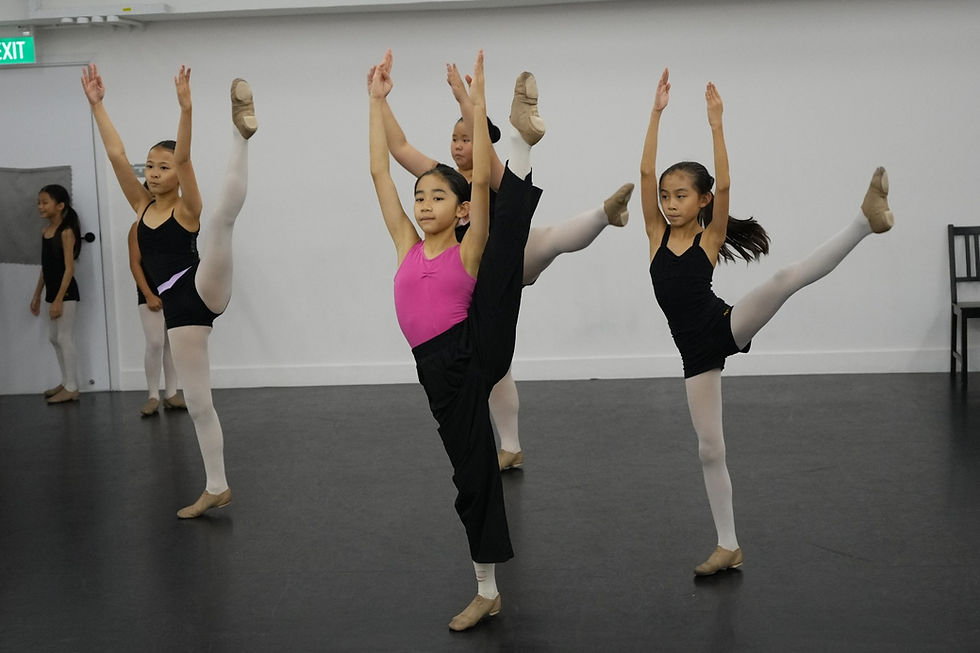Significance of The Royal Academy of Dance Syllabus
- DPA KEC
- May 28
- 3 min read
Author: Crystal Lee (RAD Registered Ballet Mistress at Dancepointe Academy Singapore)

Understanding the UK Royal Academy of Dance Syllabus Work
The Royal Academy of Dance (RAD) stands as a beacon of excellence in dance education, renowned globally for setting high standards in classical ballet. For those passionate about dance, the RAD’s structured examinations and syllabi are essential benchmarks of achievement and progress.
About the Royal Academy of Dance
Founded in 1920, the Royal Academy of Dance was established with the mission of standardising dance teaching across the UK. Today, the RAD’s influence extends to 85 countries, with 36 offices supporting a vast network of 14,000 members worldwide. The academy’s teacher training programs boast over 1,000 enrolled students, and around 250,000 students follow its syllabi for examinations. The RAD’s esteemed patron is Her Majesty Queen Elizabeth II, underscoring its prestige and significance in the arts.
The Examination Structure
The RAD's examination system is meticulously designed to guide students through a progressive journey in ballet, emphasising creativity and musicality. Certificates of achievement and, in some cases, medals, are awarded to those who pass the exams, marking their accomplishments at various stages.
Early Childhood Levels
The journey begins with the Pre-School Dance Curriculum, catering to the youngest dancers:
Level 1: Suitable for children aged 2 ½ to 3 ½ years.
Level 2: For children up to 4 ½ or 5 years.
*Children must be five years old before transitioning to the graded syllabus.
Graded Syllabus
The graded syllabus serves as the foundation of the RAD’s program, structured to accommodate children as they grow and develop:
Pre-Primary in Dance: Minimum age 5
Primary in Dance: Minimum age 6
Grades 1-5: Minimum age 7
Grades 6-8: Minimum age 11
Vocational Graded Syllabus
The vocational graded syllabus is designed for students who show a greater commitment and potential in ballet, preparing them for professional careers:
Intermediate Foundation: Minimum age 11
Intermediate: Minimum age 12
Advanced Foundation: Minimum age 13
Advanced 1: Minimum age 14
Advanced 2: Minimum age 15
Solo Seal: Minimum age 15
To advance through these vocational levels, students must meet specific prerequisites. For instance, passing the Intermediate exam is required to move to Advanced Foundation, and achieving a distinction at Advanced 2 is necessary for the Solo Seal. However, there are no prerequisites for Intermediate Foundation or Intermediate levels.

Transitioning Between Levels
Ballet teachers play a crucial role in evaluating and deciding when a student is ready to progress to the next level. While target age groups provide a general guideline, the decision ultimately lies with the instructor’s assessment of a student’s readiness.
Recognising Equivalent Qualifications
The RAD acknowledges equivalent qualifications from other reputable organisations, facilitating smooth transitions for students moving up the grades. Recognised institutions include:
- The British Ballet Organisation (BBO)
- The British Theatre Dance Association (BTDA)
- The Imperial Society of Teachers of Dancing (ISTD)
- The International Dance Teachers Association (IDTA)
The Royal Academy of Dance remains a pivotal institution in the world of ballet, offering a comprehensive and structured path for aspiring dancers. Its rigorous syllabus and examination system ensure that students not only achieve technical proficiency but also develop a deep appreciation for the artistry and discipline of ballet. For anyone passionate about dance, the RAD provides a prestigious and globally recognised framework to nurture and showcase their talents.
.png)















